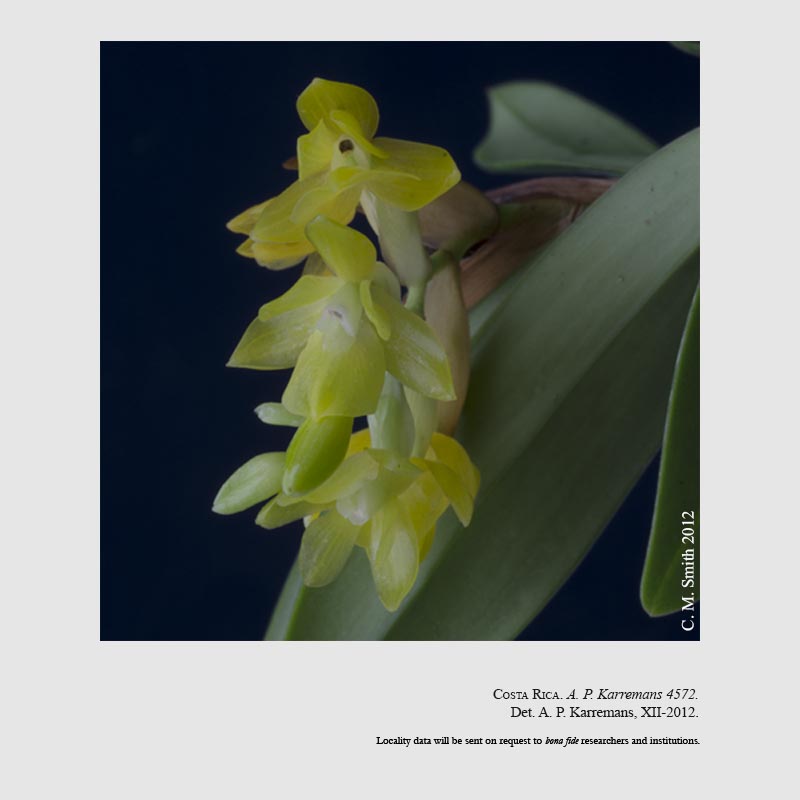

Epidendrum barbae Rchb.f. 1866 GROUP Polychlamys SUBGROUP Polychlamys
Photo © by Karremans/and The Epidendra Website
TYPE Drawing by © Jimenez, Hágsater & E.Santiago and The AMO Herbario Website
Photo © by Daniel Jimenez and his Flickr Orchid Photo Website

 LATE
LATE


Common Name The Barba Volcano Epidendrum
Flower Size 1.2” [3 cm]
Found in Costa Rica and Panama on the continental divide at elevations of 2000 to 3200 meters as a small to medium sized, cold growing epiphyte or rarely terrestrial with a simple, terete, cane-like, thin, straight stem enveloped by acute, scarious, tubular sheaths and carrying 2 to 7, clustered towards the apex, alternate, articulate, unequal, the basal leaf smaller, coriaceous, elliptic-lanceolate, acute, unequally bilobed apically, basally clasping leaves that blooms in the late winter through fall on a terminal, erect, occuring only once, racemose, distichous, arching, 1.2 to 2.6” [3 to 6.5 cm] long including the short peduncle that is hidden by the 1 to 3 bracts similar to the floral bracts, rachis, terete, thin, zig-zag, 6 to 12 flowered inflorescence with longer than the ovary, progressively shorter above, ovate, acute, yellow, conduplicate floral bracts and carrying simultaneously opening, resupinate flowers.
Distinguished by the branched stems with 2 to 3 ovate-lanceolate leaves at the apex, a peduncle that is covered by the 2 conduplicate bracts, the floral bracts are large, prominent and completely cover the ovary, the fan-shaped, retuse lip with a apical apicule.
"Epidendrum barbae belongs to the GROUP Polychlamys SUBGROUP Polychlamys which is characterized by the successive lateral growths, few leaves aggregate towards the apex of the stems, the distichous, apical inflorescence with prominent, conduplicate, acute, glumaceous floral bracts. The species is distinguished by the inflorescence with yellow or greenish yellow flowers with narrowly elliptic sepals .32 to .44" [8 to 11 mm] long, obovate petals .16 to .2" [4 to 5 mm] wide, and the suborbicular to ovate, bicallose lip with 3 keels; the nectary forms a prominent spur along the apical 2/3 of the ovary, free along the basal half. Epidendrum bugabense Hagsater has a few-flowered inflorescence with red flowers, the rachis straight and lateral sepals descending, .64 to .76" [16 to 19 mm] long, petals .32" [8 mm] wide; the lip suborbiclar obovate; nectary forming a prominent vesicle along the apical 2/3 of the ovary. Epidendrum lutheri Hágsater ; has a lax inflorescence with green to chocolate-green flowers; descending sepals wlth the margin revolute and the lip oblong, much longer than wide forming a prominent vesicle at the apical half. Epidendrum polychamys Ames also has yellow or yellowish green to rarely pink flowers with sepals .6 to 1.12" [15 to 28 mm] long, the ovary does not form a ventral vesicle, and the lip is widely oblong to obovoid." Hagsater etal 2007
Synonyms Epidendrum puteum Standl. & L.O.Williams 1953
References W3 Tropicos, Kew Monocot list , IPNI ; *Beitr. Orchid.-K. C. Amer. 83. Rchb.f 1866; The Genus Epidendrum Ames 1936; Ceiba Vol 5 No 1 L O Williams 1956; Icones Orchidacearum 2 Plate 115 Hagsater & Sanchez 1993 see recognition section; Icones Orchidacearum 3 Plate 381 Hagsater 1999 see recognition section; Manual de las Plantas de Costa Rica Vol 3 Hammel, Grayum, Herrera and Zamora 2003; Icones Orchidacearum 9 Plate 911 Hagsater & Sanchez 2007 drawing fide; Icones Orchidacearum 9 Plate 934 Hagsater 2007 see recognition section; Icones Orchidacearum 9 Plate 999 Hagsater 2007 see recognition section; Orchids of Costa Rica Vol 3 Morales 2009 photo fide;
--------------------------------------------------------------------------------------------------------------------------
----------------------------------------------------------------------------------------------------------------------------